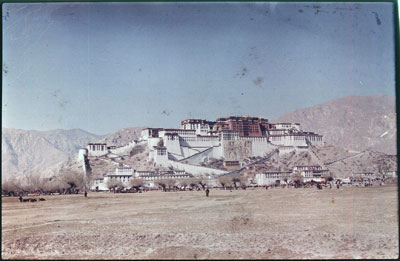
BMR.6.8.5 (Transparency colour)


BMR.6.8.5 (Transparency colour)

Hugh E. Richardson
Hugh Richardson
1936-50
Lhasa > Potala
BMR.6.8.5
60 x 90 mm
Transparency Colour
Hugh E. Richardson
This image has been flipped during scanning. You can compare the correct image above
Technical Information - The camera used to take this collection of colour slides (Dufay colour) were a Zeiss Super Ikonta and a Reflex KorelleKorelle. [KC 09/10/2006]
Manual Catalogues - Typewritten handlist entitled 'Hugh Richardson Collection, The British Museum. Photographs taken between 1936-50. Cameras: Zeiss Super Ikonta, Reflex Korelle. 300 colour slides (Dufay colour); copies made Jan. 1995.
[no.] 5. Potala Palace.' [KC 09/10/ 2006]
Other Information - Background: Richardson describes the Sertreng cerem ony in Ceremonies of the Lhasa Year, 1993, London, Serindia Publications, pp. 74-81. " ... a spectacular ceremony, the Sertreng, in which hundreds of participants marched round the Potala with banners, religious objects and music. ... the Koku - "The Silk Image" - a great applique banner which covers the lower face of he Potala for a space of some 75 by 40 feet. It consists of two panels, one rather larger than the other; in the centre of which is a huge figure of the Buddha surorunded by many deities and bodhisattvas. The priviledge of hauling it up is enjoyed by the monks of the Pempora college of Drepung. ..." [KC 12/8/ 2006]
Other Information - Setting: The Potala Palace is the winter Palace of the Dalai Lamas and the seat of traditional Tibetan government. The palace is know as several names by the Tibetan, Tse Pod rang, (rtse ph o brang) or more formally, Potala Po drang (pho brang po ta la ) The first structure was established by the legendary Tibetan Emperor Song Gampo on Mt Marpori in 637. The original structure is said to have been 11 stories high and was destroyed by lightening during the reign of Emperor Trisong Detsen. The present structure was built by the 5th Dalai Lama on the foundation of the earliest ruins. The Potala is divided into two parts, the central upper part is known as the Red P alace (pho bran g mar po) and the surrounding structure is know as the White Pa lace (pho brang dkar po). The Red Palace contains the main temple inside the palace and housed the reliquaries of the successive Dalai Lamas. The Red Palace also represents the original structure build in the 7th Century. Between 1645-1653 the 5th Dalai Lama added the White Palace and made it the seat of his government. Since the 17th Century, the White Palace has formed the main administrative offices of the Tibetan government and it became the seat of Tibetan government only in the 18th Century when the 5th Dalai Lama shifted his base from Gaden Palace in Drepung monastery to the Potala. There are said to be over 1000 rooms and over 200,000 images inside. The grounds of the Potala also housed a school known as Tse L obdra (rtse sl ob grwa) 'The Peak School'. The students were mostly boys from aristocratic families and trained to become government officials. The palace was also the site of two printing presses the older one known as Ganden Phuntsog Par khang (dpa’i ldan phun phyogs pa r khang) founded in the 17th Century and in 1920s the 13th Dalai Lama established the Shol Printing House (zhol pa r khang). [TS 27/6 /2 005]
Other Information - Setting: The Potala Palace is the winter Palace of the Dalai Lamas and the seat of traditional Tibetan government. The palace is know as several names by the Tibetan, Tse Pod rang, (rtse ph o brang) or more formally, Potala Po drang (pho brang po ta la ) The first structure was established by the legendary Tibetan Emperor Song Gampo on Mt Marpori in 637. The original structure is said to have been 11 stories high and was destroyed by lightening during the reign of Emperor Trisong Detsen. The present structure was built by the 5th Dalai Lama on the foundation of the earliest ruins. The Potala is divided into two parts, the central upper part is known as the Red P alace (pho bran g mar po) and the surrounding structure is know as the White Pa lace (pho brang dkar po). The Red Palace contains the main temple inside the palace and housed the reliquaries of the successive Dalai Lamas. The Red Palace also represents the original structure build in the 7th Century. Between 1645-1653 the 5th Dalai Lama added the White Palace and made it the seat of his government. Since the 17th Century, the White Palace has formed the main administrative offices of the Tibetan government and it became the seat of Tibetan government only in the 18th Century when the 5th Dalai Lama shifted his base from Gaden Palace in Drepung monastery to the Potala. There are said to be over 1000 rooms and over 200,000 images inside. The grounds of the Potala also housed a school known as Tse L obdra (rtse sl ob grwa) 'The Peak School'. The students were mostly boys from aristocratic families and trained to become government officials. The palace was also the site of two printing presses the older one known as Ganden Phuntsog Par khang (dpa’i ldan phun phyogs pa r khang) founded in the 17th Century and in 1920s the 13th Dalai Lama established the Shol Printing House (zhol pa r khang). [TS 27/6 /2 00
For Citation use:
The Tibet Album.
"Potala at the time of the Sertreng ceremony"
05 Dec. 2006. The British Museum.
<http://tibet.prm.ox.ac.uk/photo_BMR.6.8.5.html>.
For more information about photographic usage or to order prints, please visit the The British Museum.
© The British Museum